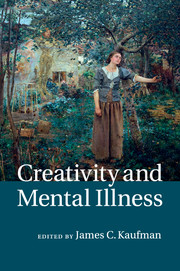Book contents
- Frontmatter
- Dedication
- Contents
- List of figures
- List of tables
- List of contributors
- Preface
- Acknowledgments
- Part I Creativity and mental illness: the state of the field
- Part II Cognitive and neuroscientific perspectives on creativity and mental illness
- Part III Creativity and the spectrum of mental illness
- Part IV Creativity and mental illness: possible commonalities
- 12 The shared vulnerability model of creativity and psychopathology
- 13 On the fragility of the artist: art’s precarious triad
- 14 Creativity as “compensatory advantage”: bipolar and schizophrenic liability, the inverted-U hypothesis, and practical implications
- Part V Creativity and mental health
- Part VI Creativity and mental illness: what now?
- Index
- References
13 - On the fragility of the artist: art’s precarious triad
from Part IV - Creativity and mental illness: possible commonalities
Published online by Cambridge University Press: 05 August 2014
- Frontmatter
- Dedication
- Contents
- List of figures
- List of tables
- List of contributors
- Preface
- Acknowledgments
- Part I Creativity and mental illness: the state of the field
- Part II Cognitive and neuroscientific perspectives on creativity and mental illness
- Part III Creativity and the spectrum of mental illness
- Part IV Creativity and mental illness: possible commonalities
- 12 The shared vulnerability model of creativity and psychopathology
- 13 On the fragility of the artist: art’s precarious triad
- 14 Creativity as “compensatory advantage”: bipolar and schizophrenic liability, the inverted-U hypothesis, and practical implications
- Part V Creativity and mental health
- Part VI Creativity and mental illness: what now?
- Index
- References
Summary
Beauty is truth, truth beauty, – that is all
Ye know on earth, and all ye need to know.
When Amy Winehouse, a 27-year-old British singer, died in her London flat in July of 2011, few were surprised. While her musical talent was prodigious (her singing was compared to that of Billy Holiday), her battle with alcohol and drug addiction also attracted public attention. Her breakout song was entitled “Rehab.” Was she not another artist sacrificed at the altar of the muses?
Are we not tripped, here, by a stereotype (Kaufman et al., 2006), seduced by an availability heuristic? After all, how many alcoholics perish quietly out of the public eye? And given that we are unable to calculate conditional probabilities for this kind of case, we may wonder whether the chance of Amy Winehouse overdosing on alcohol would have been the same if she had not been an accomplished songwriter and singer (Silvia and Kaufman, 2010).
An argument of the kind that can follow from assuming causal connections between artistic creativity and mental illness has been made by Currie (2011). He drew on a study by Post (1994) who made psychiatric diagnoses of 291 famous men from biographies. Post found that 48 percent of writers had severe psychopathology, whereas rates of psychopathology in scientists, statesmen, and thinkers were lower. On the basis of these and similar data, Currie argues that we cannot expect to learn anything useful from people who are as crazy as many writers seem to be. In this argument, Currie accepts that correlation means causality; that mental illness contributes to the writer’s art; and he assumes that the illnesses of the writers were permanent. Therefore, he concludes, one should not take the writers seriously. He also makes no comparison with levels of mental illness in the ordinary community.
- Type
- Chapter
- Information
- Creativity and Mental Illness , pp. 281 - 294Publisher: Cambridge University PressPrint publication year: 2014
References
- 1
- Cited by



